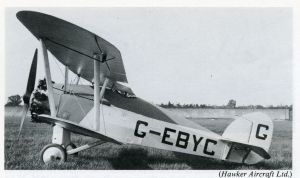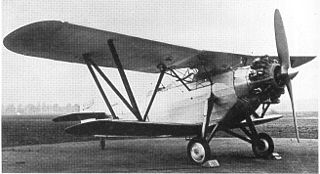Related Research Articles

The Hawker Harrier was a British experimental biplane torpedo bomber aircraft built by Hawker Aircraft to a specification issued in the 1920s for the Royal Air Force.

The Vickers Type 131 Valiant was a British general-purpose biplane produced by Vickers in 1927, with the intention of replacing the Royal Air Force's Airco DH.9As, but was unsuccessful, with only a single example built, which was sold to Chile.

The Hawker Duiker was an unusual and unsuccessful aircraft. It was the first design at Hawker under a new chief designer, Captain Thomson, in 1922. Much of the equipment and parts were proprietary and made by another aircraft company, Vickers, which shared the airfield at Brooklands with Hawker. The Duiker was a parasol wing monoplane in a period where the biplane held sway.

The Hawker Woodcock was a British single-seat fighter built by the Hawker Engineering Company as the first fighter to be produced by Hawker Engineering. It was used by the Royal Air Force (RAF) as a night fighter in the 1920s.

The Hawker Heron was the first fighter aircraft designed at Hawker Aircraft with a basically metal structure. Sydney Camm was the chief designer that introduced what became the typical structure for all Hawker aircraft until the introduction of the jet-powered Hawker P.1040. This structure consisted of metal tubes with their ends swaged so that they could be connected to each other by means of "fishplates" and bolts.

The Hawker Danecock biplane was developed from the Hawker Woodcock for the Danish air force and naval service.

The Hawker Hawfinch was a British single-engined biplane fighter of the 1920s. It was unsuccessful, with the Bristol Bulldog being selected instead.

The de Havilland DH.65 Hound was a 1920s British two-seat day bomber built by de Havilland at Stag Lane Aerodrome.

The Hawker Dantorp H.B. III was a Danish single-engined biplane bomber of the 1930s. The aircraft was a development of the British Hawker Horsley designed for the Danish Navy, but differed in being powered by a radial engine and having a third crew member. Two examples were built in Britain as a precursor to licensed production in Denmark. Financial constraints meant this was not realised and the Hawker-built examples were the only aircraft produced. They served until the German invasion of Denmark in 1940.

The de Havilland DH.29 Doncaster was a British long-range high-wing monoplane of the 1920s built by de Havilland.

The Bristol Bloodhound was a British two-seat reconnaissance/fighter aircraft designed and built by the Bristol Aeroplane Company as a possible replacement for the Bristol F.2 Fighter for the Royal Air Force. It was unsuccessful, only four prototypes being built.

The Bristol Type 101, was a British two-seat fighter prototype of the 1920s.

The Westland Interceptor was a fighter developed by the British company Westland Aircraft to Air Ministry Specification F.20/27. When tested in 1929 and 1930, it showed unsatisfactory handling characteristics and was rejected by the RAF in favour of the Hawker Fury biplane fighter.

The Blackburn R.2 Airedale was a single-engine three-seat monoplane deck-landing aircraft for land and sea reconnaissance, built in the UK in 1924. Only two were built.

The Blackburn B.T.1 Beagle was a British single-engine, two-seat biplane bomber/torpedo aircraft from 1928. Designed to Air Ministry specifications which led to no contracts for any manufacturer, only one Beagle was built.
The Nieuport London was a British night bomber aircraft designed in the First World War. A twin-engined triplane, the London was dogged by the unavailability and unreliability of its engines, and did not fly until 1920. Only two were built.

The Gloster Goring was a single-engined two-seat biplane designed to meet 1926 Air Ministry specifications for a day/torpedo bomber. It was not put into production and the one aircraft built served later as an engine testbed.

The Bristol Type 118 was a general-purpose military aircraft, a two-seat biplane built by the Bristol Aeroplane Company in the early 1930s, powered by a Bristol Mercury radial engine and aimed at overseas markets. The Type 120 was a Bristol Pegasus-engined variant entered into an Air Ministry competition and later used for armament tests. Two aircraft were built.

The Westland Witch was an unsuccessful British bomber prototype, first flown in 1928. Only a single aircraft of this type was built.

The Caproni Ca.70 was a two-seat night fighter and ground attack biplane produced in Italy in 1925. It was the only Italian aircraft designed from the outset as a night fighter.
References
- ↑ Mason 1991, pp.113-115.
- Mason, Francis K. Hawker Aircraft since 1920 London:Putnam, 1991. ISBN 0-85177-839-9.